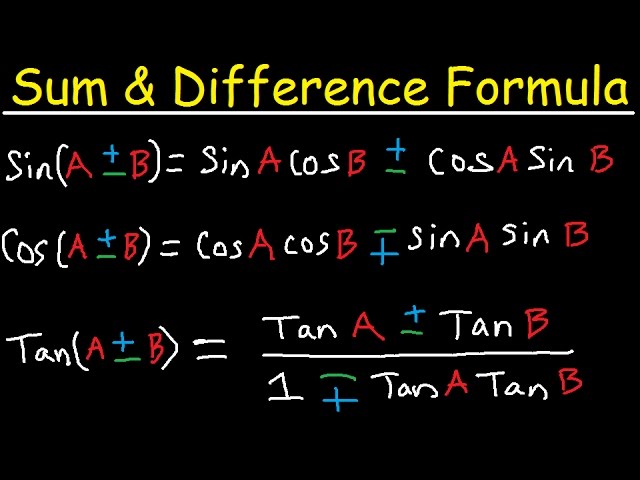Take your Trigonometry skills to the next level with Sum and Difference Trig Identities! These powerful identities simplify complex equations and help you calculate values with ease. Join us and unlock the full potential of Trigonometry today!
Sum and Difference Trig Identities
Sum and Difference Trig Identities the trigonometric functions sine, cosine, and tangent are widely used in various fields such as physics, engineering, and computer graphics. The sum and difference identities are trigonometric identities that allow us to simplify expressions involving trigonometry functions.

Trigonometry Sum and Difference Formulas
The sum identity is a formula that expresses the sine of the sum of two angles as a function of the sine and cosine of the individual angles. The most commonly used sum identity is the sine addition formula, which states that:
sin(α + β) = sin α cos β + cos α sin β
where α and β are any two angles. The cosine addition formula is similarly defined as:
cos(α + β) =cos α cos β – sin α sin β
Both of these identities are useful for simplifying expressions involving the sum of two angles, or for solving problems that require us to find the value of a trigonometric function for a sum of angles.
The difference identity is a formula that expresses the sine or cosine of the difference of two angles as a function of the sine and cosine of the individual angles. The sine difference formula states that:
sin(α – β) = sin α cos β – cos α sin β
and the cosine difference formula states that:
cos(α – β) = cos α cos β + sin α sin β
These identities are useful for simplifying expressions involving the difference of two angles, or for solving problems that require us to find the value of a trigonometric function for a difference of angles.
Sum and Difference Trig Identities – Applications
- The sum and difference identities can be used in a variety of applications. For example, they can be used to find the value of a trigonometric function for a sum or difference of angles when only the value of the function for one of the angles is known.
- They can also be used to simplify expressions involving trigonometric functions, making them easier to solve.
- One useful application of the sum and difference identities is in the evaluation of definite integrals involving trigonometric functions. The identities allow us to simplify the integrations, making it easier to evaluate the integrals.
- Additionally, the identities are useful in solving problems in physics, such as finding the position of a particle moving in a circular path.
- The sum and difference identities are also useful in the study of complex numbers. Complex numbers are mathematical objects that extend the real numbers to include a “imaginary” component.
- Trigonometric functions can be extended to complex numbers. The sum and difference identities provide a way to simplify expressions involving these functions.
In conclusion, the sum and difference identities are important trigonometric identities that allow us to simplify expressions involving trigonometric functions. They are useful in a variety of applications, including the evaluation of definite integrals, the study of complex numbers, and solving problems in physics. Understanding these identities is essential for anyone studying trigonometry or its applications.
FAQs related to trigonometry
Q: What is the sum identity for sine?
A: The sum identity for sine is sin(a + b) = sin(a)cos(b) + cos(a)sin(b).
Q: What is the difference identity for sine?
A: The difference identity for sine is sin(a – b) = sin(a)cos(b) – cos(a)sin(b).
Q: What is the sum identity for cosine?
A: The sum identity for cosine is cos(a + b) = cos(a)cos(b) – sin(a)sin(b).
Q: What is the difference identity for cosine?
A: The difference identity for cosine is cos(a – b) = cos(a)cos(b) + sin(a)sin(b).
Q: What is the tangent sum identity?
A: The tangent sum identity is tan(a + b) = (tan(a) + tan(b))/(1 – tan(a)tan(b)).
Q: What is the tangent difference identity?
A: The tangent difference identity is tan(a – b) = (tan(a) – tan(b))/(1 + tan(a)tan(b)).
Q: How are these identities used in trigonometry?
A: These identities can be used to simplify trigonometric expressions, solve trigonometric equations, and evaluate trigonometric functions for specific values of angles. They are also useful in proving other trigonometric identities.

